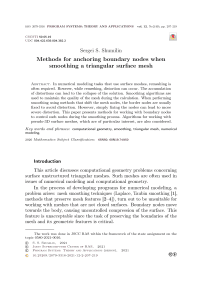Methods for anchoring boundary nodes when smoothing a triangular surface mesh
Автор: Sergei S. Shumilin
Журнал: Программные системы: теория и приложения @programmnye-sistemy
Рубрика: Программное и аппаратное обеспечение распределенных и суперкомпьютерных систем
Статья в выпуске: 2 (49) т.12, 2021 года.
Бесплатный доступ
In numerical modeling tasks that use surface meshes, remeshing is often required. However, while remeshing, distortion can occur. The accumulation of distortions can lead to the collapse of the solution. Smoothing algorithms are used to maintain the quality of the mesh during the calculation. When performing smoothing using methods that shift the mesh nodes, the border nodes are usually fixed to avoid distortion. However, simply fixing the nodes can lead to more severe distortion. This paper presents methods for working with boundary nodes to control such nodes during the smoothing process. Algorithms for working with pseudo-3D surface meshes, which are of particular interest, are also considered
Computational geometry, smoothing, triangular mesh, numerical modeling
Короткий адрес: https://sciup.org/143173921
IDR: 143173921 | DOI: 10.25209/2079-3316-2021-12-2-207-219
Список литературы Methods for anchoring boundary nodes when smoothing a triangular surface mesh
- G. Taubin. “A signal processing approach to fair surface design”, SIGGRAPH ’95: Proceedings of the 22nd annual conference on Computer graphics and interactive techniques, Association for Computing Machinery, New York, 1995, ISBN 978-0-89791-701-8, pp. 351–358.
- Z. Li, L. Ma, X. Jin, Z. Zheng. “A new feature-preserving mesh-smoothing algorithm”, The Visual Computer, 25 (2009), pp. 139–148 (Published online: 15 February 2008).
- J. Wang, Z. Yu. “Feature-preserving mesh denoising via anisotropic surface fitting”, J. Comput. Sci. Technol., 27:1 (2012), pp. 163–173.
- M. Ozsaglam, M. Cunkas. “A new smoothing algorithm for denoising mesh surfaces”, 2011 5th International Conference on Application of Information and Communication Technologies (AICT) (12–14 Oct. 2011, Baku, Azerbaijan), pp. 1–5.
- X. Tong, D. Thompson, Q. Arnoldus, E. Collins, E. Luke. “Three-dimensional surface evolution and mesh deformation for aircraft icing applications”, Journal of Aircraft, 54:3 (2016), pp. 1–17.
- X. Jiao. “Face offsetting: A unified approach for explicit moving interfaces”, Journal of Computational Physics, 220:2 (2007), pp. 612–625.
- X. Jiao. “Volume and feature preservation in surface mesh optimization”, Proceedings of the 15th International Meshing Roundtable (September 2006, Birmingham, Alabama, USA), Springer, Berlin–Heidelberg, 2006, ISBN 978-3-540-34957-0, pp. 359–373.
- J.-A. Andreas Bærentzen, J. Gravesen, F. Anton, H. Aanæs. “Laplacian and Taubin Smoothing”, Guide to Computational Geometry Processing, Ch. 9.2, Springer, London, 2012, ISBN 978-1-4471-4074-0, pp. 161–163.
- Y. Shen, K. E. Barner. “Fuzzy vector median-based surface smoothing”, IEEE Transactions on Visualization and Computer Graphics, 10:3 (2004), pp. 252–265.
- H. Borouchaki, P. Laug, P.-L. George. “Parametric surface meshing using a combined advancing-front generalized Delaunay approach”, International Journal for Numerical Methods in Engineering, 49:1–2 (2000), pp. 233–259.


